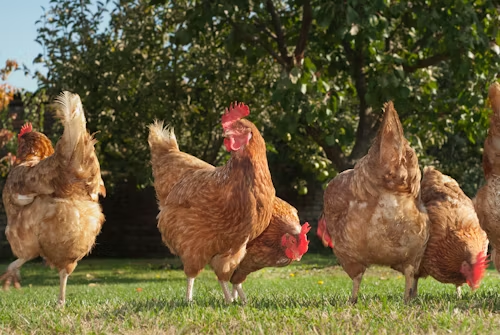The CDC recently issued a Bird Flu Response Update (March 19, 2025). It provides more details on the recent human H5N1 case from Ohio.
The human H5N1 case from Ohio:
As we previously discussed in New Human H5N1 bird flu cases: Nevada, Ohio, Wyoming, a poultry farm worker in Ohio tested positive for H5N1 in early February.
At that time, the Ohio poultry sector was hit particularly hard with outbreaks. This case was from Mercer County, which had 16 poultry farm outbreaks since the beginning of February.
The farm worker suffered respiratory symptoms and was hospitalized. Samples from the upper respiratory tract were negative. However, samples from the lower respiratory tract were positive. (The fact that H5N1 made it into the lower respiratory tract indicates prolonged contact with sick birds. It wasn’t always so easy to catch H5N1 from birds…)

The new genotype of the Ohio virus compared to other recent cases:
Notably, the CDC reports that the Ohio virus is genotype D1.3. This is the first time we’ve seen this genotype in a human.
We know from prior reports that the H5N1 viruses from the human cases in Nevada and Wyoming were genotype D1.1. This genotype has been circulating in wild birds with spillovers into poultry.
A related genotype, genotype D1.2, was found in 2 pigs and poultry in a backyard farm in Oregon. The pigs did not show symptoms but were tested after an outbreak in poultry.
The B3.13 genotype is circulating in dairy cattle. (It was only within the last few months that genotype D1.1 was found in dairy herds, first in Nevada, and then in Arizona. Prior to those detections, only B3.13 viruses were in cattle).
But why all the fuss about the genotype?

H5N1 virus genotype and why it matters:
The genotype is where the virus fits into the larger bird flu picture. As H5N1 circulates, it continues to mutate and diversify. It branches off into different clades of the family tree. The most dominant clade is 2.3.4.4b. This clade has infected wild birds, mammals, and now humans. As this clade of viruses continues to infect new hosts, the viruses continue to change.
One way to keep track of them is grouping by genotype. This refers to the makeup of the 8 genes within each virus. As an RNA virus with a segmented genome, bird flu mutates constantly. It can also mix and match its genes with other flu viruses.
On this point, a study published last month provides a helpful explanation: “While the 2.3.4.4b lineage refers to the ancestry of the hemagglutinin (HA) gene, the genotype designation describes the constellation of eight gene segments that comprise the viral genome.”
So there is a lot of variety in H5N1 clade 2.3.4.4b. The internal genetic structure of one virus may look quite different from another. Grouping them by genetic similarities helps categorize the seemingly endless versions of H5N1. This helps animal and public health authorities determine where these viruses came from and how they interact with other circulating flu viruses.
The USDA uses viral genotype to track H5N1 viruses:
In a recent update last month, the USDA set out a helpful explanation of the origin and epidemiological characteristics of recent clade 2.3.4.4b viruses. The relevant portion stated as follows:
“Genotype D1.1 is a reassortant of A3. Genotype A3 first appeared in the Pacific flyway in April of 2022 with detections only in the Pacific flyway until the fall of 2024. . . . Genotype D1.1 retains four genes from the original A3 genotype; hemagglutinin (HA), polymerase basic 1 (PB1), matrix (M) and nonstructural (NS), with other genes originating from other North American lineage viruses found in migratory wild birds. This genotype was first detected in September 2024 and has quickly expanded to all North American flyways. D1.1 is the current predominant genotype in migratory wild birds[.] The D1.1 viruses identified in dairy cattle in Nevada were found to be closely related to other D1.1 viruses recently detected in migratory wild birds across multiple North American Flyways.”

These D1 genotypes were first only circulating in wild birds. By tracking their evolution and progression, we can keep an eye out for spillovers and reassortment events. (But only if we are looking for them).
Indeed, three spillover events have already occurred with genotype D1.1 in cattle. These were in Nevada and then Arizona. These events suggest that dairy cattle not only risk infection through contaminated equipment and interstate transport, but through direct exposure to infected birds.
Indeed, the USDA states that these recent cattle spillovers “may indicate an increased risk of HPAI introduction into dairies through wild bird exposure.” One question this statement invites is does that also suggest an increase risk to humans?
What about the risks to humans from H5N1 of different genotypes?
There are very clear risks to human health from these developments.
First, genotype D1 is associated with more severe disease in humans. Indeed, all the recent severe cases have been in people infected with D1 viruses:
- In November 2024, in British Columbia, Canada, a teenager was infected with H5N1 genotype D1.1, which caused severe disease. After a lengthy hospitalization, she survived. The exact route of her exposure remains unknown.
- In December, a Louisiana man was infected with H5N1 genotype D1.1 from his backyard flock, causing severe disease. He was hospitalized and died in early January. This was the first known human case of H5N1 infection directly from backyard birds.
- In early February, the first human H5N1 case reported in Wyoming was in a woman exposed to backyard poultry. She was hospitalized in serious condition, ultimately recovering. CDC reported that this was a genotype D1.1 virus.
Second, D1 viruses may be less stable than the B3.13 viruses. This means they may face more selection pressure and undergo more changes. Indeed, sequencing of recent D1 viruses from cattle already show mutations.
The USDA stated that:
“Analysis of the hemagglutinin gene of the Nevada dairy cattle viruses did not identify changes predicted to impact infectivity or adaptation to mammalian hosts. However, a change of PB2 D701N commonly associated with mammalian adaptation of HPAI virus was identified in viruses sequenced from four separate dairy cattle. To date, this change has not been observed in D1.1 viruses found in wild birds or poultry and is not found in B3.13 genotype viruses detected in dairy cattle. PB2 D701N has previously been associated with mammalian adaptation because it improves RNA polymerase activity and replication efficiency in mammalian cells and has the potential to impact pathogenesis in infected mammals. . . . . Of note, these D1.1 viruses sequenced from dairy cattle do not contain the PB2 631L marker that appeared to be fixed in dairy cattle B3.13 sequences.”

More exposure to more H5N1 genotypes increases the risks:
Whether these viral changes are a sign of more to come cannot be known. It remains to be seen if there will be more D1 spillover events, in cattle or in humans. But my sense of unease continues to grow.
While there have been mild human infections with D1 viruses, all of the severe cases have been associated with D1 viruses. Thus, the risk profile for working with poultry or livestock may be even higher now. If the D1 genotype viruses can more readily infect dairy cattle, that increases the risk for people working with cattle. Further, every time H5N1 infects a human is another opportunity for that virus to change to better adapt to humans.
Continued vigilance is therefore warranted, especially for those with direct exposure to these animals. I would even suggest the general public exercise vigilance. Indeed, we have seen a number of human H5N1 cases with no known source of exposure.
There is clearly a gap in knowledge about the nature of the risk of H5N1 infection for people. We just don’t know how big that gap is.
Until next time.
For more bird flu updates and research study analysis, be sure to read my other articles and follow me on social media.
Leave a comment below and join the discussion, and always feel free to reach out to me!



Pingback: H5N1 and the Curious Case of Canadian Ostriches - Bird Flu Studies